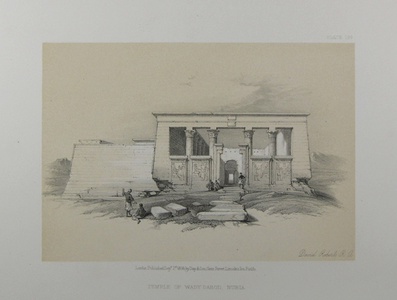| Method | Lithograph with tint stone |
| Artist | after David Roberts |
| Published | London, Published Sepr. 1st. 1856, by Day & Son, Gate Street, Lincoln's Inn Fields |
| Dimensions | Image 121 x 176 mm, Sheet 202 x 290 mm |
| Notes |
Plate 199 from Volume 5 of the small format reprint of Roberts' The Holy Land, Syria, Idumea, Arabia, Egypt & Nubia. A view of the temple at Wadi Debod, in the hills north of the island of Philae, in the ancient Egyptian region of Nubia. The temple was originally built as a simple shrine to the god Amun by a Kushite king during the Ptolemaic period. It was then extended into a temple proper by successive Ptolemaic rulers and dedicated to Isis, though it does not appear to have been completed. Much of the ornamentation was added by Augustus and Tiberius. The causeway leading to the temple from a stone quay at the River passed through three monumental pylons. The temple was gifted by the Egyptian government to Spain in the 1960s, in thanks for Spanish assistance in conserving Nubian monuments threatened by the expansion of the Aswan Dam. It was reconstructed in Parque del Oeste in Madrid, though the arrangement of the three pylons seems to differ from their original positions. In Roberts' view, a group of men rest on the rock-strewn plateau in front of the temple. The temple features a simple colonnaded courtyard with relief-carved screens and a high enclosure wall. David Roberts RA (24th October 1796 – 25th November 1864) was a Scottish painter. He is especially known for a prolific series of detailed prints of Egypt and the Near East produced during the 1840s from sketches made during long tours of the region (1838-1840). This work, and his large oil paintings of similar subjects, made him a prominent Orientalist painter. He was elected as a Royal Academician in 1841. The firm of Day & Haghe was one of the most prominent lithographic companies of the nineteenth-century. They were also amongst the foremost pioneers in the evolution of chromolithography. The firm was established in 1823 by William Day, but did not trade under the moniker of Day & Haghe until the arrival of Louis Haghe in 1831. In 1838, Day & Haghe were appointed as Lithographers to the Queen. However, and perhaps owing to the fact that there was never a formal partnership between the two, Haghe left the firm in the 1850's to devote himself to watercolour painting. The firm continued as Day & Son under the guidance of William Day the younger (1823 - 1906) but, as a result of a scandal involving Lajos Kossuth, was forced into liquidation in 1867. Vincent Brookes bought the company in the same year, and would produce the caricatures for Gibson Bowles' Vanity Fair magazine, as well as the illustrations for Cassells's Poultry Book, amongst other commissions. Condition: Light foxing to margins, not affecting image. |
| Framing | unmounted |
| Price | £30.00 |
| Stock ID | 39193 |

